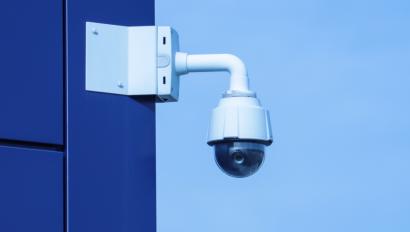How to Right-Size Your Video Surveillance Investment

When it comes to video surveillance technology, the question is seldom if the technology is needed. The real question is: Which camera or cameras will best fulfill my needs?
Many technology purchases are plagued by the same misguided symptom: spend more money, get more features. While this can be true in many cases, it doesn’t help you understand whether or not you actually need those extra features. Understanding your needs can help you not only avoid unnecessary and excessive costs, but it can also help make your business more secure.
Consider the following guidelines to make a more informed decision about IP cameras for your video surveillance system.
Resolution Impact on Network Bandwidth
When you’re using IP cameras on a network video recorder (NVR) or video management software (VMS) system, your video quality is going to be directly impacted by the amount of available network bandwidth.
Bandwidth is simply a measure of how much data can flow over your network. Generally, higher resolution cameras require more available bandwidth to transmit optimum image quality. If the bandwidth is too limited for the amount of data your cameras are trying to transmit, you may experience lower resolution video or a loss in frame rate.
Exceeding your bandwidth limitations can also lead to entire network shutdowns and other serious errors that can compromise your security, so it’s imperative to involve your IT department or discuss your network infrastructure with your security integrator.
Think of your network bandwidth like traffic on the daily commute: The more traffic (data) there is, the longer it takes to get from point A to point B. Whether you’re driving a high-end sports car or a compact sedan, you can only move as fast as traffic allows.
In much the same way, an ultra HD camera on a slow network can only transmit as much data “traffic” as the network “highway” will support, possibly resulting in pixelated image quality and stop-motion-like frame rates.
If uncompromised image quality is important to you, work with your IT department or internet service provider to ensure your network bandwidth can support your video surveillance system. The key here is to understand how much data your network infrastructure can support and make any changes necessary to ensure your system will perform well within that framework.
How Much Resolution Do You Really Need?
Understanding the limits of your network bandwidth certainly provides insight into your video surveillance system capabilities, but it says nothing about your application. Are you trying to gain visibility
into a narrow interior hallway, or do you need to monitor an entire parking lot? Do your cameras need to provide forensic-grade image quality, or simply verify human presence? Addressing what you hope to achieve through video surveillance will help you define your technical needs.
In simplistic terms, higher resolutions mean your cameras capture more detail, whereas lower resolution cameras tend to be more cost-effective. Unfortunately, enhancing image quality isn’t as easy as Hollywood often portrays, so if you need uncompromising image quality, you’ll need higher resolution cameras and the network infrastructure to support them.
All too often, business owners overspend on resolution and exceed their bandwidth. To avoid this, work closely with your security integrator to define how much resolution your ideal surveillance system actually requires. This will help you maximize your network’s stability and maximize your security investment.
What Features Do You Need?
Beyond megapixels, there are certain camera features that may or may not benefit your video surveillance surveillance system. Review the features below to further define which solution might be the best fit for you.
- IR LED/IR Illumination: This is ideal for low-light monitoring, as it utilizes the infrared spectrum and IR lamps that are invisible to the naked eye. It’s often referred to as “night vision”.
- Wide Dynamic Range: This is best for applications in which lighting conditions can rapidly change, such as an area exposed to daylight, like a main entrance. This feature enables cameras to see more detail in the light and dark areas of an image with greater clarity than conventional cameras allow.
- IR Cut Filter: This allows the camera to automatically remove an IR filter from the camera imager so more IR light from the scene can be captured by the imager in a lower light environment.
- Field of View (FOV): This is defined by the lens; it’s extremely important to select the lens properly to attain your expected FOV. The smaller the lens, the more FOV you get – a 2.8 mm lens offers a wider FOV than an 8 mm lens. However, if you want to see an area farther away, an 8 mm or higher lens will give you greater optical clarity in addition to the image sensors’ resolution capabilities.
- Power over Ethernet (PoE): An IP camera can get power and network connection using a single ethernet cable, which can reduce installation and cabling costs. When paired with an NVR that supports PoE ports, this can reduce overall bandwidth on your network.
- Edge/Local Storage: This allows you to save video files directly on the surveillance camera with the addition of an SD or micro SD memory card. This is beneficial in the event of any network dropouts or failures to capture and record events.
- Panoramic view: This allows you to see much wider scenes, such as parking lots, large fence lines, sea ports and more.
How Much Footage Do You Need to Store?
It’s very easy to lose track of how much data your video surveillance systems are recording on a regular basis. When you consider that multiple cameras are all transmitting signals at the same time, it’s easy to see how fast you can exhaust your video storage solution’s capacity.
However, it’s also important to consider each camera’s resolution. As mentioned above, higher resolution means more data flowing across your network and more storage space required. Start multiplying that data by the number of cameras on your network, and you’ll get an idea of how much storage space your system will require.
How Many Frames Per Second (FPS) Are Sufficient?
Higher frame rates mean smoother motion will be captured in your video footage. However, many higher resolution cameras capture footage with lower frame rates simply because they’re continually transmitting more data than their lower resolution counterparts. More data means more traffic on your network, which means a longer commute (and higher bandwidth requirements).
Low frame rates aren’t necessarily a bad thing, though; while high-resolution IP cameras might be capable of 30 or 60 FPS, you may find that a lower frame rate at a higher quality meets your surveillance needs without monopolizing your network’s bandwidth. The below information provides some general guidelines for common applications:
- Monitoring: 10-30 FPS
- Emergency Response: 5-30 FPS
- Investigations/Forensic Evidence: 10-30 FPS
Next Steps
Understanding your network bandwidth and choosing the right cameras for your business can be a complicated process. If you still have questions about which camera system is right for your facility and needs, contact your security integrator, who can quickly prescribe the right security system for your needs and help you answer the tough questions along the way.
Contact your trusted security integrator to get the support you need.
Disclaimer: By using the Blog section of this website (“Blog”), you agree to the terms of this Disclaimer, including but not limited to the terms of use and our privacy policy. The information provided on this Blog is for information purposes only. Such information is not intended to provide advice on your specific security needs nor to provide legal advice. If you would like to speak to a Security representative about your specific security needs, please contact us.























